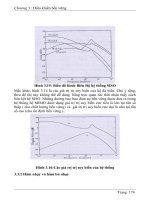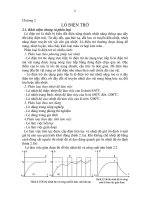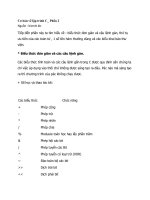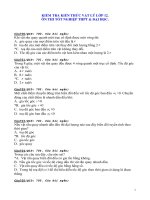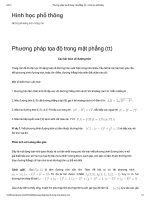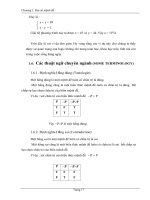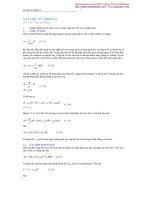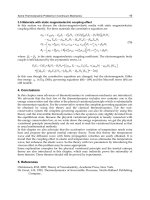Examples of VHDL Descriptions phần 2 pptx
Bạn đang xem bản rút gọn của tài liệu. Xem và tải ngay bản đầy đủ của tài liệu tại đây (36.55 KB, 10 trang )
Examples of VHDL Descriptions
tphl => 7 ns,
tplhe => 15 ns,
tphle => 12 ns);
END FOR;
FOR ALL : and3
USE ENTITY work.and3(behaviour)
GENERIC MAP(tplh => 8 ns,
tphl => 5 ns,
tplhe => 20 ns,
tphle => 15 ns);
END FOR;
END FOR;
END FOR;
END FOR;
END parts;
Generated Binary Up Counter
The first design entity is a T-type flip-flop. The second is an scalable synchronous binary up counter illustrating the use of the generate statement to produce regular structures of components.
library ieee;
use ieee.std_logic_1164.all;
entity tff is
port(clk, t, clear : in std_logic; q : buffer std_logic);
end tff;
architecture v1 of tff is
begin
process(clear, clk)
begin
if clear = '1' then
q <= '0';
elsif rising_edge(clk) then
if t = '1' then
q <= not q;
else
null;
end if;
end if;
end process;
end v1;
library ieee;
use ieee.std_logic_1164.all;
entity bigcntr is
generic(size : positive := 32);
port(clk, clear : in std_logic;
q : buffer std_logic_vector((size-1) downto 0));
end bigcntr;
architecture v1 of bigcntr is
component tff is
port(clk, t, clear : in std_logic; q : buffer std_logic);
end component;
signal tin : std_logic_vector((size-1) downto 0);
begin
genttf : for i in (size-1) downto 0 generate
ttype : tff port map (clk, tin(i), clear, q(i));
end generate;
genand : for i in 0 to (size-1) generate
t0 : if i = 0 generate
http://www.ami.bolton.ac.uk/courseware/adveda/vhdl/vhdlexmp.html (11 of 67) [23/1/2002 4:15:08 ]
Examples of VHDL Descriptions
tin(i) <= '1';
end generate;
t1_size : if i > 0 generate
tin(i) <= q(i-1) and tin(i-1);
end generate;
end generate;
end v1;
Counter using Multiple Wait Statements
This example shows an inefficient way of describing a counter.
vhdl model of a 3-state counter illustrating the use
of the WAIT statement to suspend a process.At each wait
statement the simulation time is updated one cycle,transferring
the driver value to the output count.
This architecture shows that there is no difference between
WAIT UNTIL (clock'EVENT AND clock = '1') and WAIT UNTIL clock = '1'
ENTITY cntr3 IS
PORT(clock : IN BIT; count : OUT NATURAL);
END cntr3;
ARCHITECTURE using_wait OF cntr3 IS
BEGIN
PROCESS
BEGIN
WAIT UNTIL (clock'EVENT AND clock = '1');
WAIT UNTIL clock = '1';
count <= 0;
WAIT UNTIL (clock'EVENT AND clock = '1');
WAIT UNTIL clock = '1';
count <= 1;
WAIT UNTIL (clock'EVENT AND clock = '1');
WAIT UNTIL clock = '1';
count <= 2;
END PROCESS;
END using_wait;
Counter using a Conversion Function
This counter uses a natural number to hold the count value and converts it into a bit_vector for output. Illustrates the use of a function.
4-bit binary up counter with asynchronous reset 2/2/93
ENTITY cntr4bit IS
PORT(reset,clock : IN BIT; count : OUT BIT_VECTOR(0 TO 3));
END cntr4bit;
ARCHITECTURE dataflow OF cntr4bit IS
interface function to generate output bit_vector from
internal count value.
FUNCTION nat_to_bv(input : NATURAL; highbit : POSITIVE)
RETURN BIT_VECTOR IS
VARIABLE temp : NATURAL := 0;
VARIABLE output : BIT_VECTOR(0 TO highbit);
BEGIN
temp := input;
check that input fits into (highbit+1) bits
ASSERT (temp <= (2**(highbit + 1) - 1))
REPORT "input no. is out of range" SEVERITY ERROR;
http://www.ami.bolton.ac.uk/courseware/adveda/vhdl/vhdlexmp.html (12 of 67) [23/1/2002 4:15:08 ]
Examples of VHDL Descriptions
generate bit values
FOR i IN highbit DOWNTO 0 LOOP
IF temp >= (2**i)
THEN output(i) := '1';
temp := temp - (2**i);
ELSE output(i) := '0';
END IF;
END LOOP;
RETURN output;
END nat_to_bv;
signal to hold current count value
SIGNAL intcount : NATURAL := 0;
BEGIN
conditional natural signal assignment models counter
intcount <= 0 WHEN (reset = '1') ELSE
((intcount + 1) MOD 16) WHEN (clock'EVENT AND clock = '1')
ELSE intcount;
interface function converts natural count to bit_vector count
count <= nat_to_bv(intcount,3);
END;
Quad 2-input Nand
Simple concurrent model of a TTL quad nand gate.
uses 1993 std VHDL
library IEEE;
use IEEE.Std_logic_1164.all;
entity HCT00 is
port(A1, B1, A2, B2, A3, B3, A4, B4 : in std_logic;
Y1, Y2, Y3, Y4 : out std_logic);
end HCT00;
architecture VER1 of HCT00 is
begin
Y1 <= A1 nand B1 after 10 ns;
Y2 <= A2 nand B2 after 10 ns;
Y3 <= A3 nand B3 after 10 ns;
Y4 <= A4 nand B4 after 10 ns;
end VER1;
Dual 2-to-4 Decoder
A set of conditional signal assignments model a dual 2-to-4 decoder
uses 1993 std VHDL
library IEEE;
use IEEE.Std_logic_1164.all;
entity HCT139 is
port(A2, B2, G2BAR, A1, B1, G1BAR : in std_logic;
Y20, Y21, Y22, Y23, Y10, Y11, Y12, Y13 : out std_logic);
end HCT139;
architecture VER1 of HCT139 is
begin
Y10 <= '0' when (B1 = '0') and ((A1 = '0') and (G1BAR = '0')) else '1';
Y11 <= '0' when (B1 = '0') and ((A1 = '1') and (G1BAR = '0')) else '1';
Y12 <= '0' when (B1 = '1') and ((A1 = '0') and (G1BAR = '0')) else '1';
Y13 <= '0' when (B1 = '1') and ((A1 = '1') and (G1BAR = '0')) else '1';
Y20 <= '0' when (B2 = '0') and ((A2 = '0') and (G2BAR = '0')) else '1';
http://www.ami.bolton.ac.uk/courseware/adveda/vhdl/vhdlexmp.html (13 of 67) [23/1/2002 4:15:08 ]
Examples of VHDL Descriptions
Y21 <= '0' when (B2 = '0') and ((A2 = '1') and (G2BAR = '0')) else '1';
Y22 <= '0' when (B2 = '1') and ((A2 = '0') and (G2BAR = '0')) else '1';
Y23 <= '0' when (B2 = '1') and ((A2 = '1') and (G2BAR = '0')) else '1';
end VER1;
Quad D-Type Flip-flop
This example shows how a conditional signal assignment statement could be used to describe sequential logic (it is more common to use a process). The keyword 'unaffected' is equivalent to the 'null' statement in the sequential part
of the language. The model would work exactly the same without the clause 'else unaffected' attached to the end of the statement.
uses 1993 std VHDL
library IEEE;
use IEEE.Std_logic_1164.all;
entity HCT175 is
port(D : in std_logic_vector(3 downto 0);
Q : out std_logic_vector(3 downto 0);
CLRBAR, CLK : in std_logic);
end HCT175;
architecture VER1 of HCT175 is
begin
Q <= (others => '0') when (CLRBAR = '0')
else D when rising_edge(CLK)
else unaffected;
end VER1;
Octal Bus Transceiver
This example shows the use of the high impedance literal 'Z' provided by std_logic. The aggregate '(others => 'Z')' means all of the bits of B must be forced to 'Z'. Ports A and B must be resolved for this model to work correctly (hence std_logic rather than
std_ulogic).
library IEEE;
use IEEE.Std_logic_1164.all;
entity HCT245 is
port(A, B : inout std_logic_vector(7 downto 0);
DIR, GBAR : in std_logic);
end HCT245;
architecture VER1 of HCT245 is
begin
A <= B when (GBAR = '0') and (DIR = '0') else (others => 'Z');
B <= A when (GBAR = '0') and (DIR = '1') else (others => 'Z');
end VER1;
Quad 2-input OR
uses 1993 std VHDL
library IEEE;
use IEEE.Std_logic_1164.all;
entity HCT32 is
port(A1, B1, A2, B2, A3, B3, A4, B4 : in std_logic;
Y1, Y2, Y3, Y4 : out std_logic);
end HCT32;
architecture VER1 of HCT32 is
begin
Y1 <= A1 or B1 after 10 ns;
Y2 <= A2 or B2 after 10 ns;
Y3 <= A3 or B3 after 10 ns;
Y4 <= A4 or B4 after 10 ns;
http://www.ami.bolton.ac.uk/courseware/adveda/vhdl/vhdlexmp.html (14 of 67) [23/1/2002 4:15:08 ]
Examples of VHDL Descriptions
end VER1;
8-bit Identity Comparator
uses 1993 std VHDL
library IEEE;
use IEEE.Std_logic_1164.all;
entity HCT688 is
port(Q, P : in std_logic_vector(7 downto 0);
GBAR : in std_logic; PEQ : out std_logic);
end HCT688;
architecture VER1 of HCT688 is
begin
PEQ <= '0' when ((To_X01(P) = To_X01(Q)) and (GBAR = '0')) else '1';
end VER1;
Hamming Encoder
A 4-bit Hamming Code encoder using concurrent assignments. The output vector is connected to the individual parity bits using an aggregate assignment.
ENTITY hamenc IS
PORT(datain : IN BIT_VECTOR(0 TO 3); d0 d1 d2 d3
hamout : OUT BIT_VECTOR(0 TO 7)); d0 d1 d2 d3 p0 p1 p2 p4
END hamenc;
ARCHITECTURE ver2 OF hamenc IS
SIGNAL p0, p1, p2, p4 : BIT; check bits
BEGIN
generate check bits
p0 <= (datain(0) XOR datain(1)) XOR datain(2);
p1 <= (datain(0) XOR datain(1)) XOR datain(3);
p2 <= (datain(0) XOR datain(2)) XOR datain(3);
p4 <= (datain(1) XOR datain(2)) XOR datain(3);
connect up outputs
hamout(4 TO 7) <= (p0, p1, p2, p4);
hamout(0 TO 3) <= datain(0 TO 3);
END ver2;
Hamming Decoder
This Hamming decoder accepts an 8-bit Hamming code (produced by the encoder above) and performs single error correction and double error detection.
ENTITY hamdec IS
PORT(hamin : IN BIT_VECTOR(0 TO 7); d0 d1 d2 d3 p0 p1 p2 p4
dataout : OUT BIT_VECTOR(0 TO 3); d0 d1 d2 d3
sec, ded, ne : OUT BIT); diagnostic outputs
END hamdec;
ARCHITECTURE ver1 OF hamdec IS
BEGIN
PROCESS(hamin)
VARIABLE syndrome : BIT_VECTOR(3 DOWNTO 0);
BEGIN
http://www.ami.bolton.ac.uk/courseware/adveda/vhdl/vhdlexmp.html (15 of 67) [23/1/2002 4:15:08 ]
Examples of VHDL Descriptions
generate syndrome bits
syndrome(0) := (((((((hamin(0) XOR hamin(1)) XOR hamin(2)) XOR hamin(3))
XOR hamin(4)) XOR hamin(5)) XOR hamin(6)) XOR hamin(7));
syndrome(1) := (((hamin(0) XOR hamin(1)) XOR hamin(3)) XOR hamin(5));
syndrome(2) := (((hamin(0) XOR hamin(2)) XOR hamin(3)) XOR hamin(6));
syndrome(3) := (((hamin(1) XOR hamin(2)) XOR hamin(3)) XOR hamin(7));
IF (syndrome = "0000") THEN no errors
ne <= '1';
ded <= '0';
sec <= '0';
dataout(0 TO 3) <= hamin(0 TO 3);
ELSIF (syndrome(0) = '1') THEN single bit error
ne <= '0';
ded <= '0';
sec <= '1';
CASE syndrome(3 DOWNTO 1) IS
WHEN "000"|"001"|"010"|"100" =>
dataout(0 TO 3) <= hamin(0 TO 3); parity errors
WHEN "011" => dataout(0) <= NOT hamin(0);
dataout(1 TO 3) <= hamin(1 TO 3);
WHEN "101" => dataout(1) <= NOT hamin(1);
dataout(0) <= hamin(0);
dataout(2 TO 3) <= hamin(2 TO 3);
WHEN "110" => dataout(2) <= NOT hamin(2);
dataout(3) <= hamin(3);
dataout(0 TO 1) <= hamin(0 TO 1);
WHEN "111" => dataout(3) <= NOT hamin(3);
dataout(0 TO 2) <= hamin(0 TO 2);
END CASE;
double error
ELSIF (syndrome(0) = '0') AND (syndrome(3 DOWNTO 1) /= "000") THEN
ne <= '0';
ded <= '1';
sec <= '0';
dataout(0 TO 3) <= "0000";
END IF;
END PROCESS;
END ver1;
Synchronous Down Counter with Parallel Load
This example shows the use of the package 'std_logic_unsigned' . The minus operator '-' is overloaded by this package, thereby allowing an integer to be subracted from a std_logic_vector.
LIBRARY ieee;
USE ieee.std_logic_1164.ALL;
USE ieee.std_logic_unsigned.ALL;
ENTITY pldcntr8 IS
PORT (clk, load : IN Std_logic;
datain : IN Std_logic_vector(7 DOWNTO 0);
q : OUT Std_logic_vector(7 DOWNTO 0);
tc : OUT Std_logic);
END pldcntr8;
ARCHITECTURE using_std_logic OF pldcntr8 IS
SIGNAL count : Std_logic_vector(7 DOWNTO 0);
BEGIN
http://www.ami.bolton.ac.uk/courseware/adveda/vhdl/vhdlexmp.html (16 of 67) [23/1/2002 4:15:08 ]
Examples of VHDL Descriptions
PROCESS
BEGIN
WAIT UNTIL rising_edge(clk);
IF load = '1' THEN
count <= datain;
ELSE
count <= count - 1;
END IF;
END PROCESS;
tc <= '1' WHEN count = "00000000" ELSE '0';
q <= count;
END using_std_logic;
Mod-16 Counter using JK Flip-flops
Structural description of a 4-bit binary counter. The first two design entities describe a JK flip-flop and a 2-input AND gate respectively. These are then packaged together along with a signal named 'tied_high' into a package named
'jkpack'. The counter design uses the package 'jkpack', giving it access to the components and the signal declared within the package. The flip-flops and AND-gates are wired together to form a counter. Notice the use of the keyword
OPEN to indicate an open-cct output port.
ENTITY jkff IS
PORT(clock, j, k : IN BIT; q, qbar : BUFFER BIT);
END jkff;
ARCHITECTURE using_process OF jkff IS
BEGIN
sequential process to model JK flip-flop
PROCESS
declare a local variable to hold ff state
VARIABLE state : BIT := '0';
BEGIN
synchronise process to rising edge of clock
WAIT UNTIL (clock'EVENT AND clock = '1');
IF (j = '1' AND k = '1') THEN toggle
state := NOT state;
ELSIF (j = '0' AND k = '1') THEN reset
state := '0';
ELSIF (j = '1' AND k = '0') THEN set
state := '1';
ELSE no change
state := state;
END IF;
assign values to output signals
q <= state AFTER 5 ns;
qbar <= NOT state AFTER 5 ns;
END PROCESS;
END using_process;
ENTITY and_gate IS
PORT(a, b : IN BIT; f : OUT BIT);
END and_gate;
ARCHITECTURE simple OF and_gate IS
BEGIN
f <= a AND b AFTER 2 ns;
END simple;
PACKAGE jkpack IS
http://www.ami.bolton.ac.uk/courseware/adveda/vhdl/vhdlexmp.html (17 of 67) [23/1/2002 4:15:08 ]
Examples of VHDL Descriptions
SIGNAL tied_high : BIT := '1';
COMPONENT jkff
PORT(clock, j, k : IN BIT; q, qbar : BUFFER BIT);
END COMPONENT;
COMPONENT and_gate
PORT(a, b : IN BIT; f : OUT BIT);
END COMPONENT;
END jkpack;
USE work.jkpack.ALL;
ENTITY mod16_cntr IS
PORT(clock : IN BIT; count : BUFFER BIT_VECTOR(0 TO 3));
END mod16_cntr;
ARCHITECTURE net_list OF mod16_cntr IS
SIGNAL s1,s2 : BIT;
BEGIN
a1 : and_gate PORT MAP (count(0),count(1),s1);
a2 : and_gate PORT MAP (s1, count(2), s2);
jk1 : jkff PORT MAP (clock,tied_high,tied_high,count(0),OPEN);
jk2 : jkff PORT MAP (clock,count(0),count(0),count(1),OPEN);
jk3 : jkff PORT MAP (clock,s1,s1,count(2),OPEN);
jk4 : jkff PORT MAP (clock,s2,s2,count(3),OPEN);
END net_list;
Pseudo Random Bit Sequence Generator
This design entity uses a single conditional signal assignment statement to describe a PRBSG register. The length of the register and the two tapping points are defined using generics. The '&' (aggregate) operator is used to form a
vector comprising the shifted contents of the regsiter combined with the XOR feedback which is clocked into the register on the rising edge.
The following Design Entity defeines a parameterised Pseudo-random
bit sequence generator, it is useful for generating serial or parallel test
waveforms
(for paralle waveforms you need to add an extra output port)
The generic 'length' is the length of the register minus one.
the generics 'tap1' and 'tap2' define the feedabck taps
ENTITY prbsgen IS
GENERIC(length : Positive := 8; tap1 : Positive := 8; tap2 : Positive := 4);
PORT(clk, reset : IN Bit; prbs : OUT Bit);
END prbsgen;
ARCHITECTURE v2 OF prbsgen IS
create a shift register
SIGNAL prreg : Bit_Vector(length DOWNTO 0);
BEGIN
conditional signal assignment shifts register and feeds in xor value
prreg <= (0 => '1', OTHERS => '0') WHEN reset = '1' ELSE set all bits to '0'
except lsb
(prreg((length - 1) DOWNTO 0) & (prreg(tap1) XOR prreg(tap2))) shift
left with xor feedback
WHEN clk'EVENT AND clk = '1'
ELSE prreg;
connect msb of register to output
prbs <= prreg(length);
END v2;
http://www.ami.bolton.ac.uk/courseware/adveda/vhdl/vhdlexmp.html (18 of 67) [23/1/2002 4:15:09 ]
Examples of VHDL Descriptions
Pelican Crossing Controller
Pelican Crossing Controller
library ieee;
use ieee.std_logic_1164.all;
entity pelcross is
port(clock, reset, pedestrian : in std_logic;
red, amber, green : out std_logic); traffic lights
end pelcross;
architecture v1 of pelcross is
signal en, st, mt, lt, fr : std_logic;
begin
timer for light sequence
interval_timer : block
constant stime : natural := 50;
constant mtime : natural := 80;
constant ltime : natural := 200;
signal tcount : natural range 0 to ltime;
begin
process begin
wait until rising_edge(clock);
if (en = '0') or (tcount = ltime) then
tcount <= 0;
else
tcount <= tcount + 1;
end if;
end process;
st <= '1' when tcount = stime else '0';
mt <= '1' when tcount = mtime else '0';
lt <= '1' when tcount = ltime else '0';
end block;
free running timer for amber flashing
free_run : block
constant frtime : natural := 5;
signal frcount : natural range 0 to frtime;
begin
process begin
wait until rising_edge(clock);
if frcount = frtime then
frcount <= 0;
else
frcount <= frcount + 1;
end if;
end process;
fr <= '1' when frcount = frtime else '0';
end block;
moore state machine to control light sequence
controller : block
type peltype is (res, stop, amb, amb_on, amb_off, grn, ped);
signal pelstate : peltype;
begin
process(clock, reset)
begin
if reset = '1' then
pelstate <= res;
elsif rising_edge(clock) then
case pelstate is
when res => pelstate <= stop;
when stop => if lt = '1' then
pelstate <= amb;
http://www.ami.bolton.ac.uk/courseware/adveda/vhdl/vhdlexmp.html (19 of 67) [23/1/2002 4:15:09 ]
Examples of VHDL Descriptions
else
pelstate <= stop;
end if;
when amb => pelstate <= amb_on;
when amb_on => if mt = '1' then
pelstate <= grn;
elsif fr = '1' then
pelstate <= amb_off;
else
pelstate <= amb_on;
end if;
when amb_off => if mt = '1' then
pelstate <= grn;
elsif fr = '1' then
pelstate <= amb_on;
else
pelstate <= amb_off;
end if;
when grn => if pedestrian = '1' then
pelstate <= ped;
else
pelstate <= grn;
end if;
when ped => if st = '1' then
pelstate <= res;
else
pelstate <= ped;
end if;
when others => pelstate <= res;
end case;
end if;
end process;
moore outputs
with pelstate select
en <= '1' when stop|amb_on|amb_off|ped,
'0' when others;
with pelstate select
red <= '1' when res|stop,
'0' when others;
with pelstate select
amber <= '1' when amb|amb_on|ped,
'0' when others;
with pelstate select
green <= '1' when grn,
'0' when others;
end block;
end v1;
Pelican Crossing Controller test bench
library ieee;
use ieee.std_logic_1164.all;
entity peltest is
end peltest;
architecture v1 of peltest is
signal clock, reset, pedestrian, red, amber, green : std_logic;
component pelcross is
port(clock, reset, pedestrian : in std_logic;
red, amber, green : out std_logic); traffic lights
end component;
begin
10 Hz clock generator
process begin
http://www.ami.bolton.ac.uk/courseware/adveda/vhdl/vhdlexmp.html (20 of 67) [23/1/2002 4:15:09 ]
